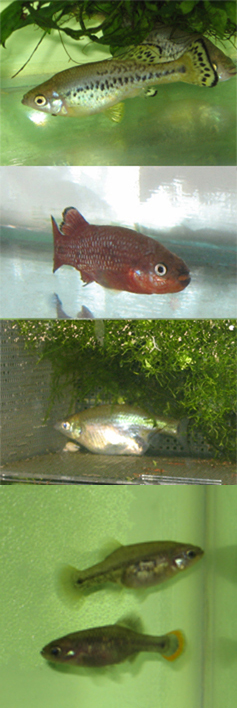|
The
Goodeids are a very different type of fish, and can be recognized by
generally possessing
a few similar,
distinguishable body shapes. Many of the species in this family are
threatened
or near extinction within the central
high plains of Mexico, and their method of reproduction is of
particular interest. A compilation of the Goodeids and their
conservation status, as published
by Dr. John Lyons is
here.
Unlike the reproduction of the swordtails,
mollies, guppies and platies, Goodeid reproduction
is viviparous- more like our own. Similar to the other livebearers, they
have internal fertilization,
but instead of a gonopodium
like guppies and swordtails, the male possesses a fin adaptation
called an andropodium. This "notch" in
the anal fin can be seen in the top pic of the male
Ilyodon furcidens,
just forward of the ventral fin. Click
here for an enlarged image.
The young develop while being
directly nourished by the mother before they are born,
unlike other
livebearers. Similar to an umbilical cord in mammals, the goodeid
structure, the
trophotaenia, nourishes each fry
during its development, falling off shortly after birth.
Generally unknown in the commercial tropical fish hobby, they are some
of the most interesting
and attractive fish that
can be kept in the home aquarium. Most are peaceful with one another,
and generally good community fish,
though adult Ilyodon
furcidens can take care of themselves
when picked upon.
The newborn fry are much
larger than the young of other
livebearers, but the number of young
within each
drop is smaller. Unfortunately, some, such as the
Z. tequila will still eat their fry,
while other species may not. My
largest drop from a goodeid was from the female
Skiffia multipunctata
pictured at left who dropped 19 fry. Generally expect 10-15, and a
female's first brood is usually 5-10. They do not require any special
requirements, preferring
planted tanks, and do best with
temperatures in the low to mid
70ís. They do not tolerate
warmer temperatures
for extended periods. (Above 78-80).
After 3 years of making an
effort to maintain large numbers of them here, some species
do not reproduce quickly enough or in large enough numbers to
meet demand, and must
be pulled occasionally to allow their numbers to build back
up. The S. multipunctata and
C. lateralis- two of the most attractive, are examples of
this. A recent broad restructuring
of the fishroom- the introduction of hydroponics fans and
firm fitting tops on all of the
aquariums to hold down on moisture production, and to better
stabilize tank temperatures,
for example, caused an overall warming that those two species
did not respond well to. The
Z. tequila and
I. furcidens, interestingly, reproduce
very well and the slight change in
temperature did not affect them at all.
Further complicating matters, many goodeid species- again the C. lateralis and
S. multipunctata come to mind, tend to breed seasonally, and
will cease reproduction from
approximately October through April.
For each species there is a
Care Guide providing more
information, addressing the
problems some fishkeepers encounter, specific to each species.
The Care Guides can
be seen by clicking
Here.
Pictured
at left: Top- Male Ilyodon furcidens,
2nd from top- Characodon lateralis (No Longer at
Select Aquatics)
3rd from top- Gravid S. multipunctata
(No Longer at Select Aquatics)
Bottom pic-
Pair Zoogoneticus tequila
Home
Contact Us
Receiving Shipped Fish
Keeping Select
Aquatics Fish
X |
 |
